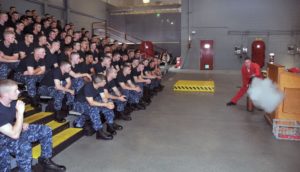Effective leadership styles vary from a control style to a participative style. The right leadership style should depend on the situation and the leaders’ objective.
 At times a control style of leadership is appropriate. Think of a fire brigade that is called into action to fight a blaze. The fire chief must assume a control style of leadership since it is an emergency and tight control is required from the commander.
At times a control style of leadership is appropriate. Think of a fire brigade that is called into action to fight a blaze. The fire chief must assume a control style of leadership since it is an emergency and tight control is required from the commander.
However, when there is no fire the chief takes a participative leadership style and engages in activities such as debriefing, problem solving, training, coaching, rewarding etc. Training as a fire fighter is crucial for proper decision making and execution of tasks when there is a real fire to fight.
 The same is true for leaders and managers in organizations. They need to vary their style according to the situation so that their employees are fully capable to perform at the levels expected.
The same is true for leaders and managers in organizations. They need to vary their style according to the situation so that their employees are fully capable to perform at the levels expected.
Leaders and managers often spend too much time fighting their own organizational fires, rather than engaging their staff in discussion, problem solving, training and coaching.
It’s quite easy for a leader or manager to think they are doing their job well when in fact they might be taking a control style of leadership too often by solving problems for their employees and telling them what to do.
By adapting a coaching and participative style of leadership, the leader recognizes and understands the importance of setting aside time to provide training and coaching, and engaging employees in continuous improvement initiatives.
A participative leadership style results from a decision that a leader or manager makes to make this their preferred style of leadership. It also requires that the leader or manager develops the skills to be this type of leader.
Leadership Skills
Some of the skills that a leader or manager needs to learn and practice to master a participative leadership style is listening, visioning, sharing thoughts and feelings, goal setting, empowering, recognizing, giving feedback, training and coaching.
The leader who wants to adapt a participative leadership style must also develop good self-knowledge. Different types of people have different strengths and challenges when it comes to the aforementioned leadership skills.
A leader who is an assertive action type might be too controlling with people and find it hard to listen and empathize with others.
A leader who is good in strategy and logistics might tend to over analyze things and be afraid to share decision making with his team, thus also be too controlling but in a different way than the action type leader.
In conclusion the leader or manager that wants to develop high performance empowered employees and teams needs to learn how to adapt a participative leadership style most of the time. This is a process that unfolds over time and does not happen overnight. On-going skills development congruent with self-knowledge is crucial for this to be fully realized.